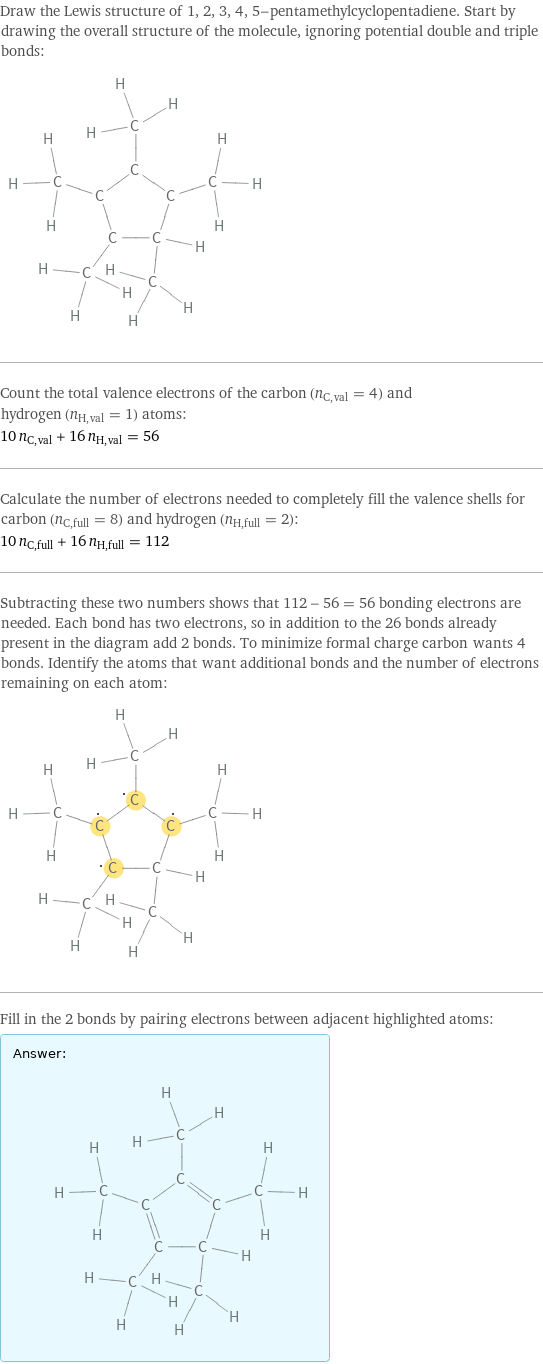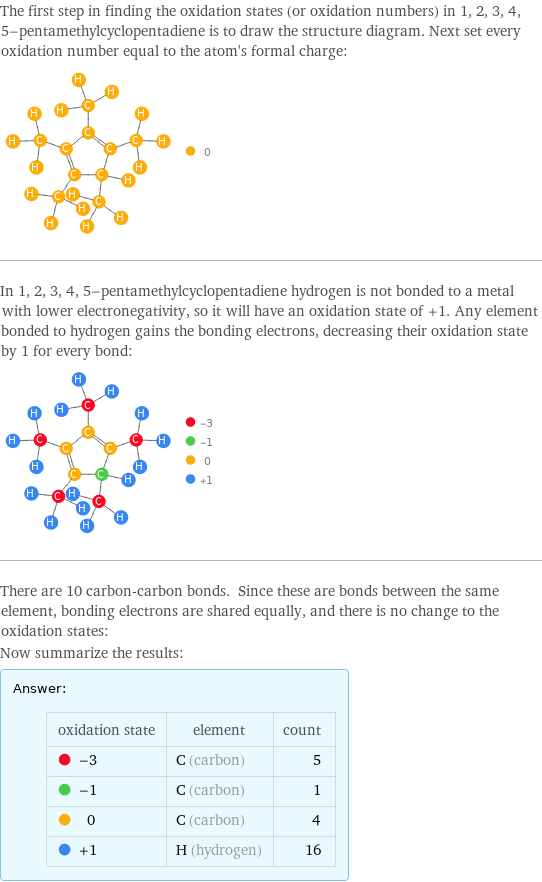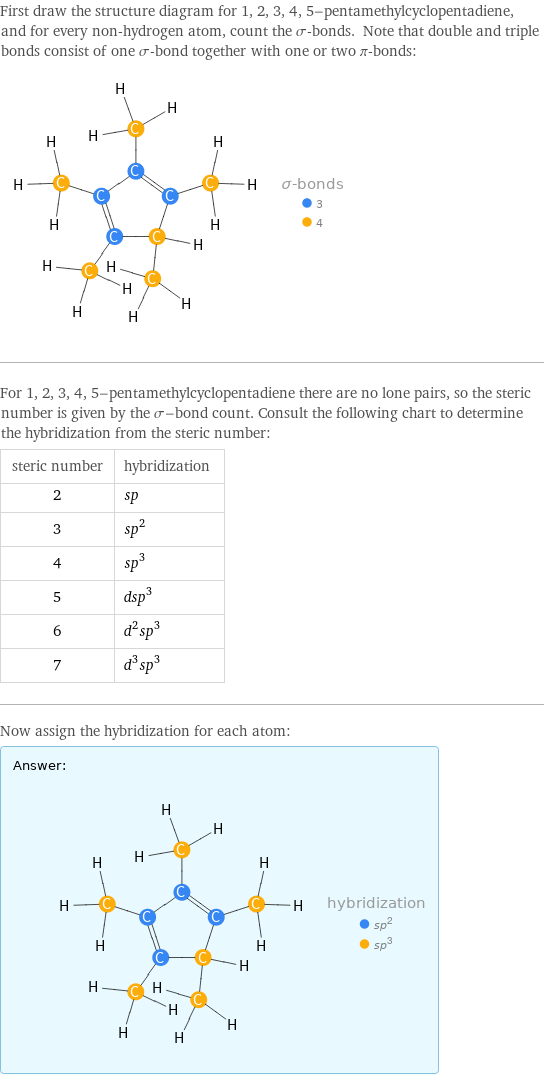Input interpretation

1, 2, 3, 4, 5-pentamethylcyclopentadiene
Basic properties

molar mass | 136.2 g/mol formula | C_10H_16 empirical formula | C_5H_8 SMILES identifier | CC1C(=C(C)C(=C1C)C)C InChI identifier | InChI=1/C10H16/c1-6-7(2)9(4)10(5)8(6)3/h6H, 1-5H3 InChI key | WQIQNKQYEUMPBM-UHFFFAOYSA-N
Lewis structure

Draw the Lewis structure of 1, 2, 3, 4, 5-pentamethylcyclopentadiene. Start by drawing the overall structure of the molecule, ignoring potential double and triple bonds: Count the total valence electrons of the carbon (n_C, val = 4) and hydrogen (n_H, val = 1) atoms: 10 n_C, val + 16 n_H, val = 56 Calculate the number of electrons needed to completely fill the valence shells for carbon (n_C, full = 8) and hydrogen (n_H, full = 2): 10 n_C, full + 16 n_H, full = 112 Subtracting these two numbers shows that 112 - 56 = 56 bonding electrons are needed. Each bond has two electrons, so in addition to the 26 bonds already present in the diagram add 2 bonds. To minimize formal charge carbon wants 4 bonds. Identify the atoms that want additional bonds and the number of electrons remaining on each atom: Fill in the 2 bonds by pairing electrons between adjacent highlighted atoms: Answer: | |
Estimated thermodynamic properties

melting point | -8.19 °C boiling point | 188.6 °C critical temperature | 660.1 K critical pressure | 2.535 MPa critical volume | 508.5 cm^3/mol molar heat of vaporization | 41.3 kJ/mol molar heat of fusion | 16.48 kJ/mol molar enthalpy | -120 kJ/mol molar free energy | 91.27 kJ/mol (computed using the Joback method)
Units

Quantitative molecular descriptors

longest chain length | 5 atoms longest straight chain length | 0 atoms longest aliphatic chain length | 0 atoms aromatic atom count | 0 atoms H-bond acceptor count | 0 atoms H-bond donor count | 0 atoms
Elemental composition

Find the elemental composition for 1, 2, 3, 4, 5-pentamethylcyclopentadiene in terms of the atom and mass percents: atom percent = N_i/N_atoms × 100% mass percent = (N_im_i)/m × 100% Plan: • Write the chemical formula and gather atomic masses from the periodic table. • Determine values for N_i, m_i, N_atoms and m using these items. • Finally, compute the percents and check the results. Write the chemical formula: C_10H_16 Use the chemical formula to count the number of atoms, N_i, for each element and find the total number of atoms, N_atoms, per molecule: | number of atoms C (carbon) | 10 H (hydrogen) | 16 N_atoms = 10 + 16 = 26 Divide each N_i by N_atoms to calculate atom fractions. Then use the property that atom fractions must sum to one to check the work: | number of atoms | atom fraction C (carbon) | 10 | 10/26 H (hydrogen) | 16 | 16/26 Check: 10/26 + 16/26 = 1 Compute atom percents using the atom fractions: | number of atoms | atom percent C (carbon) | 10 | 10/26 × 100% = 38.5% H (hydrogen) | 16 | 16/26 × 100% = 61.5% Look up the atomic mass, m_i, in unified atomic mass units, u, for each element in the periodic table: | number of atoms | atom percent | atomic mass/u C (carbon) | 10 | 38.5% | 12.011 H (hydrogen) | 16 | 61.5% | 1.008 Multiply N_i by m_i to compute the mass for each element. Then sum those values to compute the molecular mass, m: | number of atoms | atom percent | atomic mass/u | mass/u C (carbon) | 10 | 38.5% | 12.011 | 10 × 12.011 = 120.110 H (hydrogen) | 16 | 61.5% | 1.008 | 16 × 1.008 = 16.128 m = 120.110 u + 16.128 u = 136.238 u Divide the mass for each element by m to calculate mass fractions. Then use the property that mass fractions must sum to one to check the work: | number of atoms | atom percent | mass fraction C (carbon) | 10 | 38.5% | 120.110/136.238 H (hydrogen) | 16 | 61.5% | 16.128/136.238 Check: 120.110/136.238 + 16.128/136.238 = 1 Compute mass percents using the mass fractions: Answer: | | | number of atoms | atom percent | mass percent C (carbon) | 10 | 38.5% | 120.110/136.238 × 100% = 88.16% H (hydrogen) | 16 | 61.5% | 16.128/136.238 × 100% = 11.84%
Elemental oxidation states

The first step in finding the oxidation states (or oxidation numbers) in 1, 2, 3, 4, 5-pentamethylcyclopentadiene is to draw the structure diagram. Next set every oxidation number equal to the atom's formal charge: In 1, 2, 3, 4, 5-pentamethylcyclopentadiene hydrogen is not bonded to a metal with lower electronegativity, so it will have an oxidation state of +1. Any element bonded to hydrogen gains the bonding electrons, decreasing their oxidation state by 1 for every bond: There are 10 carbon-carbon bonds. Since these are bonds between the same element, bonding electrons are shared equally, and there is no change to the oxidation states: Now summarize the results: Answer: | | oxidation state | element | count -3 | C (carbon) | 5 -1 | C (carbon) | 1 0 | C (carbon) | 4 +1 | H (hydrogen) | 16
Orbital hybridization

First draw the structure diagram for 1, 2, 3, 4, 5-pentamethylcyclopentadiene, and for every non-hydrogen atom, count the σ-bonds. Note that double and triple bonds consist of one σ-bond together with one or two π-bonds: For 1, 2, 3, 4, 5-pentamethylcyclopentadiene there are no lone pairs, so the steric number is given by the σ-bond count. Consult the following chart to determine the hybridization from the steric number: steric number | hybridization 2 | sp 3 | sp^2 4 | sp^3 5 | dsp^3 6 | d^2sp^3 7 | d^3sp^3 Now assign the hybridization for each atom: Answer: | |
Topological indices

vertex count | 26 edge count | 26 Schultz index | 4654 Wiener index | 1245 Hosoya index | 27849 Balaban index | 4.017